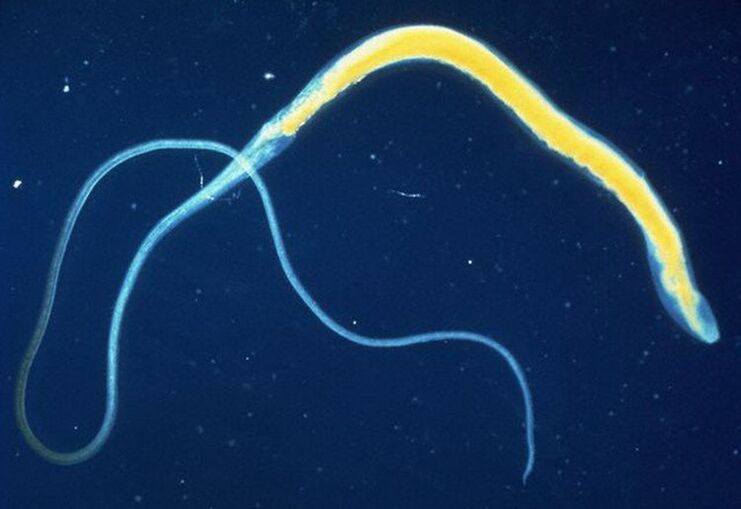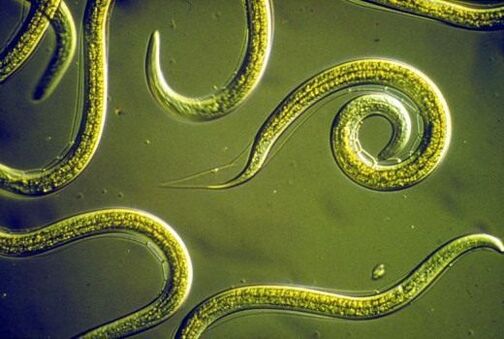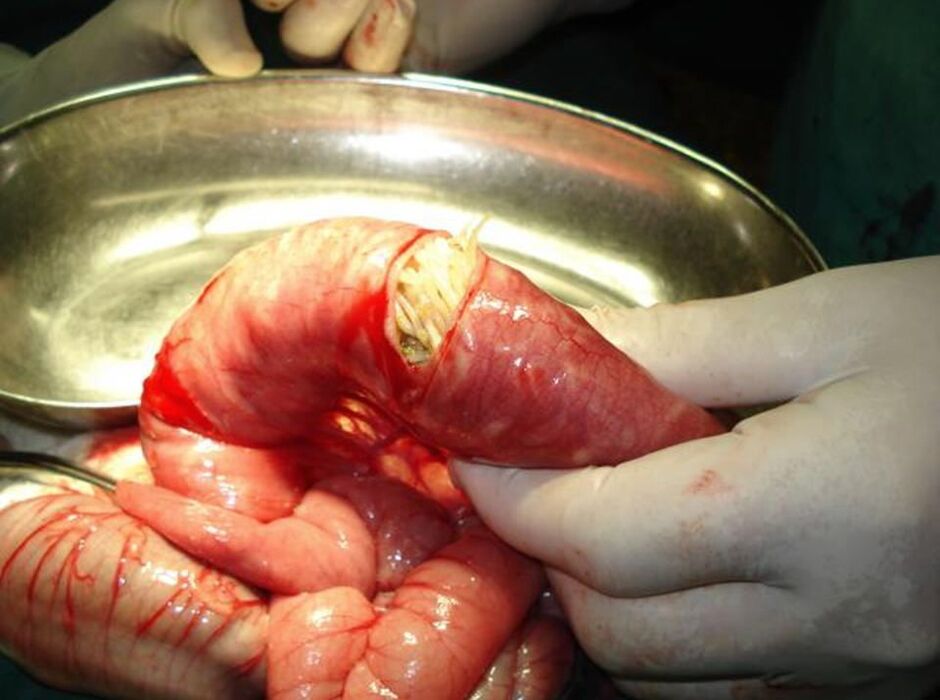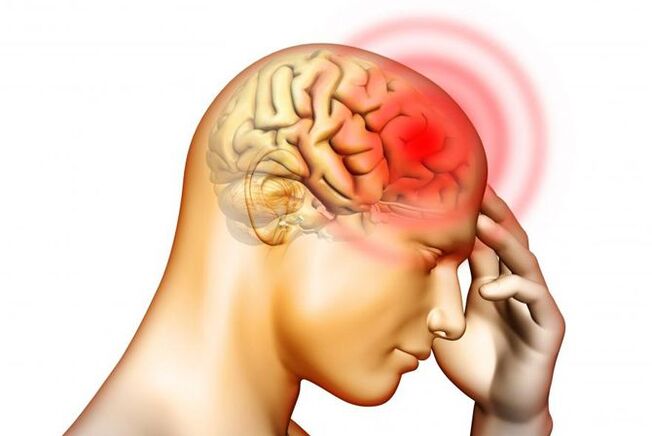Worms in the human body are parasites that do not exist in the body, they can only exist and reproduce through a host (human or animal). Parasitic diseases caused by human worms themselves or by their larvae. The disease is spread by an infectious way, the penetration of helminths is often unnoticed, and over time, it will cause disorders in the body.
First of all, you should understand what helminths are. This is a general term for parasitic worms on the human body, in the body of animals or even plants. This explanation also answers the question what worms are. The terms "worm" and "helminth" are synonyms.
The most dangerous infestation of helminths is in the asymptomatic form, which leads to diseases due to nutritional deficiencies. Intestinal parasites live by absorbing nutrients from the human body. The colonization of spirochetes can be detected in the late stages, after the onset of other symptoms of the presence of intestinal parasites.
Some intestinal parasite larvae can reach various body tissues. In this case, inflammatory deposits are formed, as the immune system recognizes the larvae as foreign organisms. Some allergic reactions of the immune system can occur due to the presence of helminths in humans.
When worms appear in a person, the symptoms and treatment of the infestation are closely related to the elimination of the cause of the discomfort, which is the parasite, and the signs of its presence also disappear. pass away.
How to infect parasites
There are many factors that contribute to the appearance of worms. Their appearance can be caused by the following cases:
- one of the most common risk factors for helminthiasis is the influence of mass travel;
- in second place is water and food pollution;
- helminths can be infected after eating meat products, sausages;
- poorly washed vegetables are the main source of parasite larvae;
- The transmission of worms from pets is often documented.
Symptoms of parasitic diseases
Worm infestation can manifest itself in different ways, depending on the type of parasite. The most common symptoms are as follows:

- constipation - difficulty having a bowel movement caused by worms - is the result of an obstruction of the flow of the intestines;
- diarrhea - loose stools appear due to contact with substances secreted by the parasites that lose potassium and chloride;
- flatulence and bloating - parasites cause inflammation and gas in the small intestine;
- muscle and joint pain - filariasis is often characterized by the location of the worms even in synovial fluid and muscle tissue;
- allergy - the parasite punctures the intestinal wall, as a result of which undigested molecules enter the bloodstream, causing an allergic reaction;
- skin problems - with helminthiasis, skin problems such as acne, rashes and itching are common;
- anemia - parasites attach to the intestinal mucosa and "steal" nutrients, leading to anemia;
- granuloma - a tumor-like focal point formed around the egg of the parasite;
- nervous - worms produce toxins that irritate the central nervous system, as a result, psychological signs may appear;
- sleep disturbances - night anxiety accompanied by the invasion of helminths for the following reasons: at this time the worms leave the rectum, the liver's activity increases, trying to excrete the toxins produced by them;
- chronic fatigue is one of the first signs of parasites in the body;
- cancer.

Pinworm
Pinworms are one of the most common intestinal parasites in the human body. These worms have the scientific name Enterobiusvermicularis. They are distributed all over the world. Despite the fact that these worms are mainly characteristic of the children's body and are most common in the group of children, they are also found in adults.
Infection occurs when the larvae of the parasite are ingested anywhere in an infected person's environment. They are present on skin, under fingernails, in bedding, clothing and dust. In the duodenum, the larvae develop into adult parasites, which then migrate to the large intestine.
The adult pinworm is about 1 cm long, thin, like a white thread. They lay eggs in the perianal area. This is manifested by the most characteristic symptoms of the disease - unpleasant sensations and itching in the anorectal area.
Complications of parasitic infections are chronic enteritis, in girls - secondary vaginal infections.
Two-thirds of people infected with intestinal parasites are not aware of the presence of helminthiasis, as they often experience no symptoms other than anxiety, irritability and fatigue.
Vlasoglav

The second most common intestinal parasite is the flagellate, Trichuristrichiura. Infections caused by this type of worm are often asymptomatic, making it difficult to determine exactly who is infected.
An adult flagellum is 3-5 cm long. Contagion of worms occurs orally - through the use of contaminated food or water, as well as through contaminated soil. The larvae of the parasite hatch in the small intestine, while the adult worms nest in the large intestine. Adult females lay eggs, which hatch with manure and hatch in warm soil 5 weeks after nesting.
In the worst case scenario, flagella causes only abdominal pain, diarrhea or nausea. More serious complications of this infection occur only in tropical areas. In severe cases, there may be chronic diarrhea or anemia.
Nematode
Human roundworms include 2 types of parasites - Ancylostomaduodenale and Necatoramericanus. Adult females are 10-13 mm (A. duodenale) or 9-11 mm (N. americanus), males 8-11 mm (A. duodenale) and 7-9 mm (N. americanus).

Eggs are eliminated from the host body in the feces. Under favorable conditions (wet, warm), larvae hatch within 1–2 days in soil or in manure, and after 5–10 days they become capable of transmitting disease. Under favorable natural conditions, they can survive for 3-4 weeks.
Contact with the human body occurs through penetration of the parasite larvae through the skin. Through the bloodstream, they reach the heart and lungs, enter the pulmonary alveoli, then from the bronchial tree into the pharynx, the patient swallows them. The larvae reach the small intestine, where they stay for the time needed to develop into adult worms.
Adult worms live in the small intestine, attach to the intestinal wall and feed on the blood of a human host. Most of these parasites are cleared from the body within 1-2 years, but their record of parasitic ability in the body can go up to decades.
The larvae of the A. duodenale worm penetrate the human skin dormant (whether in the intestines or muscles). In addition, A. duodenale infection can also be transmitted orally. However, the N. americanus worm requires migration.
Roundworm
Roundworm - Ascarislumbricoides - also belongs to the category of intestinal parasites. An adult worm can be up to 25 cm long. Human helminths of this type remain latent for a long time. Their symptoms are usually fatigue and cough, which in most cases are due to other reasons.
For helminth infections, just unwashed vegetables and fruits are enough.

The larvae of these worms nest and hatch in the small intestine, penetrating the intestinal wall. Through the flow of blood and lymph, they reach the lungs, causing a cough. When coughing, green mucus is expelled, roundworms will return to the intestine after swallowing. Roundworm eggs are excreted in the feces.
The most common source of person-to-person transmission is the feces of an infected person.
In severe cases, roundworms can cause inflammatory processes in the body, often pneumonia. In most cases, however, people infected with worms remain asymptomatic or the symptoms are so mild that neither the patient herself nor the primary care physician suspect an intestinal parasite infection.
The disease caused by roundworms is called ascariasis. The main route of infection is the fecal-oral route.
According to WHO estimates, the prevalence of worms is about 1 billion people each year.

In adult helminths, symptoms and treatment depend on the site of the worm, and are characterized by a wide range of clinical manifestations - from asymptomatic to severe cases, even death. Common symptoms are abdominal discomfort and pain, diarrhea, rectal itching or allergic manifestations. During the early stages of migration, the larvae of the parasite can cause signs of inflammation in the lungs (Loeffler syndrome), pancreas, myocardium, liver, and other organs.
Roundworms in the intestines are the cause of metabolic disorders and nervous system disorders.
Roundworms in the respiratory system
As the worms travel through the human body, they pass through the pharynx, where they reside in the lymph nodes surrounding the main lymphatic chain (Waldeyer's chain).
Where worm larvae may be present:
- lymph glands and salivary glands;
- pharynx;
- larynx;
- the area along the ear canal leading to the middle ear;
- All pathways lead to the brain.
The lateral nasopharynx has an opening leading to the Eustachian tube, which connects the pharynx to the middle ear. This allows the pressure in the ear to be equalized with atmospheric pressure. By these routes, the larvae of the worms can reach the middle ear. The result is hearing loss, tinnitus, headaches, and Meniere's syndrome - dizziness, accompanied by moments of memory loss.

Pulmonary manifestations of roundworms
When roundworms damage the lungs, diseases of this organ and skin signs in the form of roughness and rash occur. These symptoms are accompanied by a slightly elevated temperature, but sometimes fever. People with dry cough, bronchitis and hoarse voice. Left untreated, ascariasis can develop into chronic problems with seasonal flare-ups and eventually cause severe asthma. The person becomes addicted to drugs, and sometimes even retires on disability benefits.
Roundworms in other organs
Because the larvae of the worms invade other organs, there are slight bleeding and signs of infection. They can invade the pancreas, biliary tract, and liver. In the small intestine, the larvae clump together into a "clump", causing intestinal obstruction. Parasitic larvae live in the aforementioned organs throughout a person's life, feeding on their metabolites and causing mechanical damage to them.
They can invade the pancreas, biliary tract, and liver. In the small intestine, the larvae clump together into a "clump", causing intestinal obstruction. Parasitic larvae live in the aforementioned organs throughout a person's life, feeding on their metabolites and causing mechanical damage to them.
When there are larvae in the liver and biliary tract, the liver is weakened and cannot excrete toxic substances naturally. They are thus excreted through the skin, causing allergies, rashes, "unexplained" subcutaneous swelling and other manifestations with many variations, from dry eczema to purulent processes.
Roundworm in the brain
Symptoms of brain invasion vary depending on where the worm larvae are located. If they are located in the meninges, there is a risk of meningoencephalitis accompanied by a migraine. When localizing the grooves, granulomas are formed in the gray crust.
Then the symptoms of brain carcinoma appear: loss of consciousness, seizures, convulsions. If the granuloma is located near the optic or auditory nerve, deafness or visual impairment will occur.
Tapeworms
Chain - Taeniasaginata, Taeniasolium - is one of the oldest and best known intestinal parasites. It can reach a record length - up to 9 m.

The two most common worms are the beef tapeworm (Taeniasaginata) and the pork tapeworm (Taeniasolium). Both types enter the body after eating raw or improperly cooked meat. The eggs of the parasite are long and are parasitic in the small intestine. Adult worms develop after 3 months. The terminal parts of the worm's body are filled with eggs, which are released individually and excreted in the feces. The larvae are able to enter the bloodstream through the intestinal lining, then migrate to the muscles and brain, where they settle.
Despite the severity of the disease, tapeworms don't necessarily cause immediate symptoms, so it won't be visible for a long time. The chain in the muscle causes myalgia, in the brain - epilepsy.
Parasites are detected by X-ray or computed tomography. An accurate diagnosis can only be made on the basis of these studies.
Treatment of parasites
There are many different ways to treat worms. These include the widespread use of antiparasitic herbs and the most modern bioremediation.
Herbs against parasites
The rules for using antiparasitic herbs are based on the location of the worms in the body.

Receiving guests half an hour before a meal is recommended in the following cases:
- parasites in the intestines and lower body;
- Secondary infection with worms of the genitourinary system.
Application with food: damaged by parasites of the stomach, colon, liver and spleen.
Use after meals: parasitic infections of the upper body, lungs, neck, head.
Recommendations for the use of antiparasitic herbs:
- Do NOT use for pregnant;
- One of the common deworming herbs is wormwood, which should not be used for people with stomach ulcers.
Chemical antiparasitic drugs
The most effective are drugs containing carbamic acid methyl esters. This active ingredient is used to treat pinworms, roundworms, roundworms, tapeworms. When treating pinworms, the dosage is taken according to the instructions. Treatment of other parasites with these drugs depends on age.
Adherence to dosage is important to avoid cramps.

Treatment by applying a treatment frequency on a bioprocessor and using a plasma generator
These devices destroy pathogens in the body without any negative side effects. When using a bioprocessor, electrical pulses pass through the tissues, when using a plasma generator - radio waves, causing vibrations of the parasitic membrane. The result is rupture of the membranes and consequent destruction of the parasites. For each type of microorganism, a specific frequency is applied.
During the treatment of this worm, it is very important to adhere to the dietary measures: exclude alcohol intake and subsequent detoxification. Dead worms must be eliminated from the body, or they will become enclosed and act like allergens.
All existing parasites are eliminated by treatment with these methods. Therapy is carried out in 2 stages:
- stage 1: removal of small parasites - 20 minutes for each microorganism;
- stage 2 - removal of large worms - first, frequency is applied to destroy eggs, then larvae and finally adult worms.
Optimal treatment time:
- Protozoa: plasma - 5 minutes per frequency; biological treatment - 20 minutes per frequency.
- Multicellular: plasma - 10 minutes per frequency; biological treatment - 4 × 20 minutes using 1 frequency.
The use of a plasma generator, in addition to significantly reducing procedure time, has another great advantage - when using this machine it is possible to accommodate 5 people and animals at the same time. Its operating range is up to 5 m.
Conclusion
Treating worms includes removing sugar, baked goods, and potatoes – these foods create the ideal environment for the worms to survive.
In the case of treating a child's illness, it is recommended to give the child to eat roasted pumpkin seeds to chew - about 30 seeds, 3 times a day. They should not be eaten with the main food.
Eating raw garlic in moderation will also help with deworming.
Deworming will not be effective without proper cleaning. Washing hands, regularly washing bedding, pillows and dishes are the basis of effective therapy.






























